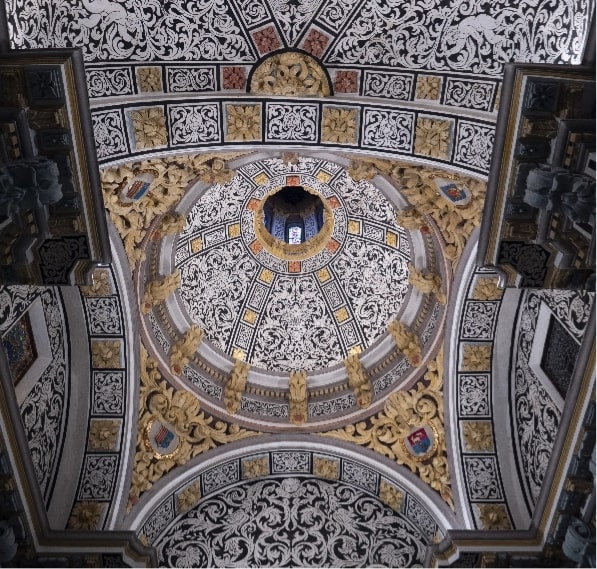
Mausoleum of the Amantes
The current Mausoleum of the Amantes was inaugurated in September of 2005. The building, designed by the architect Alejandro Cañada, offers numerous exposition halls whose goal is to offer more insight into the history of the Amantes.
From a conceptual point of view, there are four existing sections of the exposition:
Sector I. El Amor en tiempos difíciles / Love in Times of Difficulty. We explain the social characteristics, politics and culture concerning the events surrounding Teruel at the beginning of the 13th century.
Sector II. La Historia de los Amantes / The History of the Amantes. It is important to expose the events which occurred in 1217, Teruel, between Juan Martinez de Marcilla and Isabel de Segura. We also touch on the historical debate that this relationship created over the centuries.
Sector III. Los Amantes, fuente de inspiración / The Amantes: a source of inspiration. This area was designed in order to explain the influence of the Amantes in the world of the arts (literature, theatre, music, painting and sculpture) over time.
Sector IV. El Reposo de los Amantes / The Resting Place of the Amantes. Here you will find the Mausoleum of the Amantes, a work attributed to the sculptor Juan de Avalos. Across a series of panels, you will appreciate the discovery of the two mummies and the very location, meaning and purpose that the Mausoleum has served over the years.

History of the Amantes
The story of the Amantes originates from an ancient tradition, later documented. In the early years of the 13th century, Juan Diego de Marcilla and Isabel de Segura lived in the city, whose early friendship soon turned into love. Rejected by the family due to lack of wealth as a second son, the suitor manages to obtain a five-year period to enrich himself. He goes to war and returns to Teruel when the deadline expires. Isabel is already the wife of a brother of the lord of Albarracín. Juan Diego manages to meet her at her house and asks for a kiss. Isabel denies him, and the young man dies of grief. The next day, the funeral is held at the Church of Saint Peter. A mourning woman approaches the coffin: it is Isabel, who wants to give the deceased the kiss she denied him in life. She does so, and suddenly dies beside him. In 1555, the mummies buried in the chapel of San Cosme and San Damián were discovered. According to the later testimony of the notary Yagüe de Salas, an ancient document was found that recounted the event. Juan de Ávalos sculpted the recumbent statues under which the mummies now rest. The cold serenity of The Lovers, whose hands do not touch, is a symbol of a love that transcends human concepts.
Updated version by papel de letra antigua, dated to the end of the 14th century
In Teruel, a young man named Juan Martinez de Marcilla fell in love with Isabel de Segura, daughter of Pedro Segura. The father had no other female child and was a very wealthy man. The two fell in love upon first meeting. The young Juan asked for Isabel’s hand in marriage, and she responded with equal enthusiasm. However, Isabel said that it would not be possible without their parents’ consent. Knowing this, Juan still wanted Isabel as his wife. He was a good man, though not a wealthy one.
The young man asked his beloved to wait for him for five years while he moved heaven and earth to gain money and therefore convince Isabel’s father to bless the marriage. She agreed, and promised to wait for his return.
A war against the Moors, fought both on land and on sea, would allow the young Juan to earn one thousand old coins or sueldos at the end of the five years.
During this time, Isabel was consistently pushed by her father to marry another. Her response to her father was always that she had promised to remain a virgin until the age of twenty, and that she had to be of mature age in order to be able to run a household before getting married. Due to her father’s love for her, Pedro accepted her refusal to wed another.
Five years pass and Pedro tells his daughter: My darling, my desire is simply for you to find a companion. Isabel, having waited the promised five years for her love, with no news, told her father that she would accept and find another. Soon after, her father found her someone and they were soon after wed. At this point, Juan returned.
Juan got close to his love’s bedside and asked her to kiss him, or he would die. She responded that God would not want her to betray her husband. For the love of our Lord Jesus Christ, I beg you to find another woman, I am no longer available and you should forget me. If this does not please God, then it does not please me either. Juan asks a second time for a kiss, or he would suffer death. She said that she would not kiss him.
Juan then died at her feet. Isabel, who could see him perfectly thanks to the lighting in the room, began to tremble and awoke her husband claiming that he was snoring so loud that it scared her. She asked him to tell her something. He told her a joke. She then told him that there was something else: what truly happened to Juan…that he died with his last breath, begging her to kiss him.
Her husband then answered: Oh! How tragic, and why did you not kiss him? Isabel responded that she did not want to betray her husband. Certainly, he said, for you are honorable.
So, he got up, uncertain of what to do. He said: If people found out he died here, they would think that I killed him and I would be placed in a difficult position.
The couple agreed to move Juan’s body to the house of his father. All of this was done in secret, without being seen or heard by anyone…
The young Segura began to think about Juan and how much he had loved her, and had done for her and how simply refusing to kiss him, killed him. She decided then that she would kiss him one last time before he was buried beneath the earth. She then went to the Church of Saint Peter. The weeping women all looked at her. Isabel ignored them and focused solely on the deceased. She found his face and kissed him with so much passion, that she died. Onlookers went up to her in order to remove her from Juan’s body when they realized suddenly that she was dead. Her husband then told the truth to everyone present and made the decision to bury the Amantes together in the same tomb.
The stories and scenes that surround this history are numerous. Here you found a brief history, summarizing the story of the Amantes.





